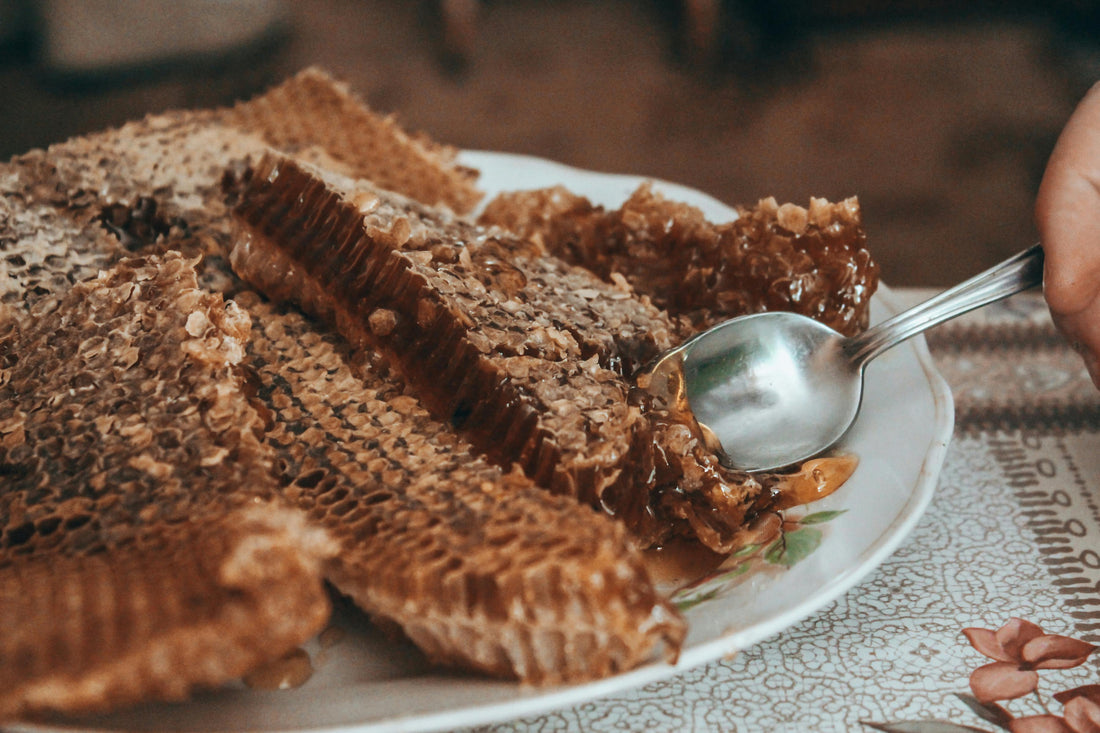If you’ve ever opened a jar of honey only to find it grainy or solidified, you might’ve wondered: "Is this still good to eat?" Don’t worry, your honey hasn’t gone bad. Crystallization is a natural process that tells you your honey is raw and unprocessed. But why does this happen, and what’s the science behind it? Let’s dive into the sweet world of honey and its quirks.
The Science Behind Honey Crystallisation
At its core, honey is a supersaturated solution of sugar—mainly glucose and fructose—dissolved in water. The balance between these two sugars plays a major role in honey's tendency to crystallize.
Glucose tends to solidify and form crystals, while fructose stays liquid.
When glucose separates from the water, it starts to form crystals, giving the honey that grainy or thick texture. This happens more quickly in some types of honey than others, depending on the glucose-to-fructose ratio. For instance, honey with more glucose (like clover honey) crystallizes faster than those higher in fructose (like acacia honey).
Does Crystallisation Mean the Honey Has Gone Bad?
No, absolutely not. Crystallization is a completely natural process that happens to pure, raw honey. It’s a sign that your honey hasn’t been overly processed or heated. Processed honey often stays liquid longer because it has been pasteurized (heated) to dissolve the glucose crystals and extend its shelf life. However, raw honey, which retains its natural enzymes and nutrients, is more prone to crystallisation.
Factors That Influence Crystallisation
Now that we know why honey crystallizes, let’s explore the factors that influence this process:
- Temperature: Honey crystallizes more quickly at cooler temperatures, especially between 10–15°C (50–60°F). So, if you’re storing your honey in a cold pantry or fridge, it’ll crystallize faster. Warmer environments slow down the crystallization process but may degrade some of honey's natural qualities.
- Type of Honey: As mentioned earlier, the glucose-to-fructose ratio plays a big role. For example, clover honey, which is high in glucose, tends to crystallize rapidly, while other types like tupelo or acacia, which have a higher fructose content, remain liquid for a longer time.
- Pollen Content: The amount of pollen and other natural particles in honey also contributes to crystallization. Raw honey, which hasn’t been filtered, contains tiny particles of pollen and wax, and these act as nuclei for glucose crystals to form around.
- Water Content: The water content in honey can vary, but generally, honey has less than 20% water. When there’s less water, the glucose separates more easily from the solution, speeding up crystallisation.
Can I Still Eat Crystallised Honey?
Yes, crystallized honey is perfectly safe to eat. In fact, some people prefer it because it’s easier to spread on toast and has a creamier texture. If you’re not a fan of the crystallized texture, you can easily return it to a liquid state (decrystallize) by gently warming the honey. Just place the jar in a pot of warm water (not boiling!) and stir until the crystals dissolve. Avoid using a microwave, as high heat can destroy the honey’s beneficial enzymes and nutrients.
Is There a Way to Prevent Honey from Crystallizing?
While you can’t stop honey from crystallizing forever, there are a few ways to slow down the process:
- Store it properly: Keep your honey at room temperature (around 20–25°C or 68–77°F) and avoid refrigeration.
- Use a clean spoon: Introducing moisture from a wet spoon can encourage crystallization, so always use a dry spoon when scooping honey.
- Choose the right type of honey: If you prefer liquid honey, opt for varieties with a higher fructose content, like acacia or tupelo.
The Upside to Crystallised Honey
Believe it or not, there are perks to crystallized honey. When honey crystallizes, it becomes thicker and creamier, making it perfect for spreading on toast or stirring into yogurt. The taste remains just as delightful, and some argue that crystallized honey has a richer flavour because the concentration of glucose crystals enhances its natural sweetness.
Conclusion
So, why does honey crystallize? The answer lies in its natural composition and environment. It’s a process that occurs in raw, unprocessed honey and is a sign of its purity. Far from being a flaw, crystallization is a natural and harmless phenomenon that you can embrace or reverse if you prefer. Whether you enjoy it smooth or slightly grainy, honey remains one of nature’s sweetest, healthiest gifts.
Next time you see your honey crystallising, remember that it’s just the honey being its natural, wholesome self, no need to worry.
Reference
Epicurious (2023). Why Does Honey Crystallize? (And How Do You Bring It Back to Life If It Does?) Retrieved from https://www.epicurious.com/expert-advice/why-does-honey-crystallize

